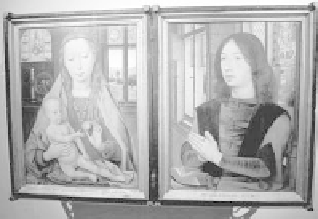Travel Reference
In-Depth Information
mated by a well-placed necklace of small stones.
Memling accentuates her fashionably pale complexion and
gives her a pensive, sober expression, portraying her like a medieval
saint. Still, she keeps her personality, with distinct features like
the broad nose, neck tendons, and realistic hands. She peers out
from her subtly painted veil, which sweeps down over the side of
her face. What's she thinking?
Diptych of Martin van Nieuwenhove
(1489)
Three-dimensional effects—borrowed from the Italian Renais-
sance style—enliven this traditional two-panel altarpiece. Both
Mary-and-Child and the 23-year-old Martin, though in different
panels, inhabit the same room within the painting.
Stand right in front of Mary, facing her directly. If you line up
the paintings' horizons (seen
in the distance, out the room's
windows), you'll see that both
panels depict the same room—
a room with two windows at
the back and t wo along the
right wall.
Want proof? In the convex
mirror on the back wall (just to
the left of Mary), the scene is
reflected back at us, showing Mary and Martin from behind, sil-
houetted in the two “windows” of the picture frames. Apparently,
Mary makes house calls, appearing right in the living room of
the young donor Martin, the wealthy, unique-looking heir to his
father's business.




















